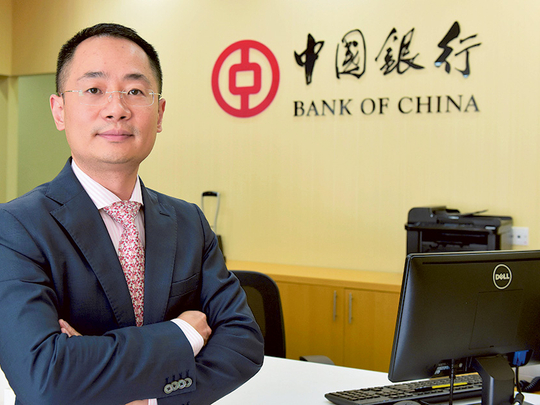
Abu Dhabi: Bank of China, which opened its branch in Abu Dhabi in March, plans to have a major presence in the UAE and expand its operations as the trade ties between China and the UAE become stronger.
Bank of China is the second bank to be licensed by the UAE Central Bank after Industrial and Commercial Bank of China. It plans to play an important role in financing projects under China’s One Belt, One Road strategy aimed at reviving ancient Silk Route passing through dozens of countries in Central Asia and Europe.
A representative of the company said the economic relations between China and the UAE are getting stronger.
“The bilateral trade between China and the UAE volume reached as high as $54.8 billion last year, a new record. As the tied become stronger, we want to expand our network and finance both Chinese and local companies in the region,” said Tian Jun, General Manager of Bank of China Abu Dhabi Branch
Bank of China has the longest continuously operating history in China with investment, insurance, commercial and aircraft leasing sectors has listed two billion Chinese Yuan ($322 million; Dh1.18 billion) bond on Nasdaq Dubai last week.
The bank will use the capital raised to support cross-border trade and infrastructure activities linking various regions of the globe under China’s ‘One Belt, One Road’ strategy.
“Our strategy is to provide financial services along this stretch. Currently we have 17 branches, subsidiaries and offices alongside the Belt and the Road and plan to expand. Our target is to cover 50 per cent of the 65 countries”
“We are going to finance infrastructure projects, roads, electricity, energy projects etc. There are many Chinese companies involved along this belt.”
One Belt, One Road is a development strategy and framework, proposed by China that focuses on connectivity and cooperation among countries primarily in Eurasia.
It consists of two main components, the land-based Silk Road Economic Belt and oceangoing Maritime Silk Road.
The strategy underlines China’s push to boost trade take a bigger role in global affairs and aimed at reviving the ancient trade routes that span Asia, Africa and Europe.
It was unveiled by Chinese leader Xi Jinping in 2013.
Among the projects under the plan are a network of railways, highways, oil and gas pipelines, power grids, internet networks, maritime and other infrastructure links across Central, West and South Asia to as far as Greece, Russia and Oman, increasing China’s connections to Europe and Africa.
Bank of China will invest or finance $100 billion in the coming three to five years time on this belt.
“We will invest all the 65 countries in the region. These are developing countries and they need infrastructure. It is a win-win strategy.”
Tian said the UAE is interested in China’s “Belt and Road” initiative, and would like to join Beijing in promoting strategic partnership to even higher levels.
“In 2012, the two nations officially became strategic partners, and their cooperation since then has been growing. For many years, UAE has stayed as China’s second largest trading partner and top commodity importer in West Asia and North Africa.”
“The UAE is the founding member of the Asian Infrastructure Investment Bank (AIIB) in Beijing. It shows the strong ties between the two countries.”
AIIB is expected to start official operations by the end of 2015. It seeks to provide new financial resources for infrastructure development and improvement across Asia.
According to Tian, there are more than 3,000 Chinese companies operating in the UAE and the number is growing.
“The reason why we chose Abu Dhabi to open our branch is that we see huge potential in the energy sector. China National Petroleum Corporation has an office and there are ongoing projects.”












